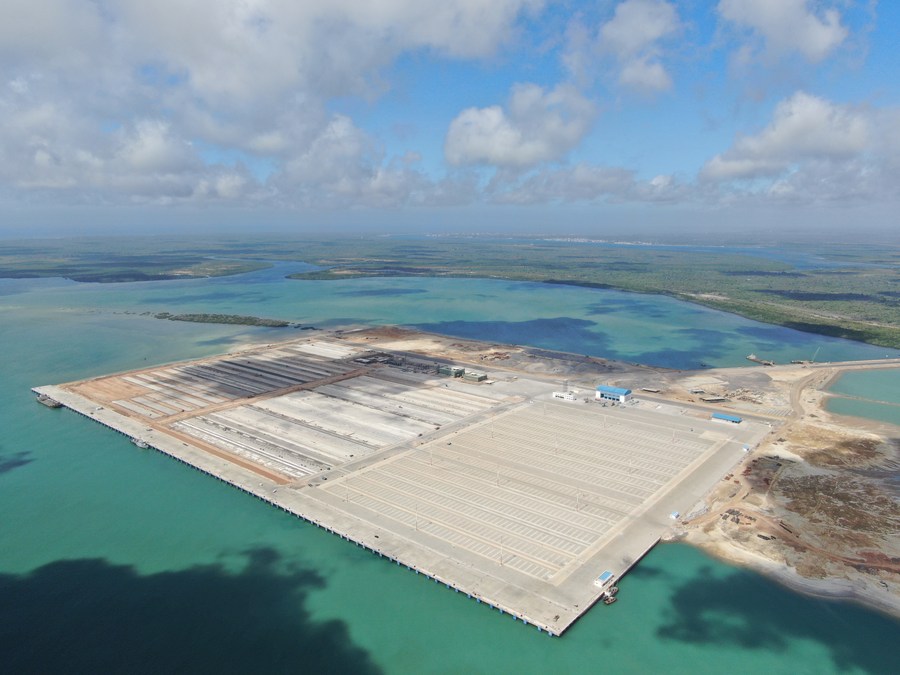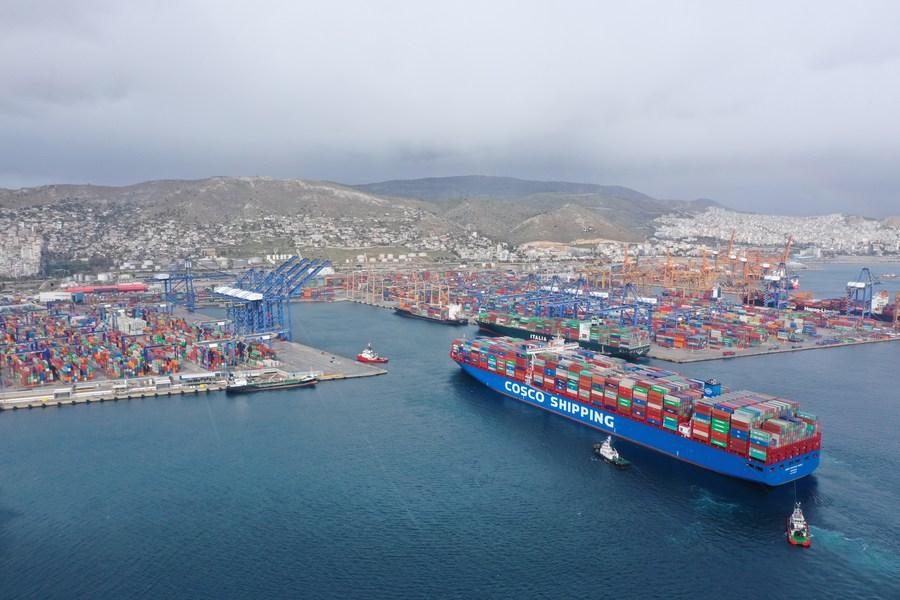
Photo taken on Jan. 29, 2018 shows a view of Gwadar Port in southwest Pakistan's Gwadar. (Xinhua/Ahmad Kamal)
BEIJING, Feb. 24 (Xinhua) -- In recent years, Belt and Road (B&R) countries have been actively enhancing sea route connectivity and ports cooperation through improving port operation and infrastructure construction, in a bid to promote unimpeded global trade.
According to statistics from the United Nations Conference on Trade and Development, 80 percent of global trade in goods is carried out by sea.
-- Turning the Gwadar Port into an oasis of prosperity
As a major piloting project under the Belt and Road Initiative between China and Pakistan, the Gwadar Port has witnessed continuous progress in recent years in terms of port construction, Gwadar Free Zone development and infrastructure building. "The changes taking place here in Gwadar are quite obvious ever since its inauguration in November 2016," said Naseer Khan Kashani, chairman of the Gwadar Port Authority.
The Gwadar Port has achieved full operational capacity and is proactively expanding its business scope. Cooperating with Ningbo-Zhoushan port in east China's Zhejiang Province, the Gwadar Port is heading toward transforming itself into a logistics hub, as well as an industrial base.
Construction of the first phase of Gwadar Free Zone has been completed, with a total investment of over 3 billion yuan (about 474.23 million U.S. dollars) involving more than 40 enterprises. Construction of the second phase was launched in July 2021, attracting more and more investors with its area 36 times larger than the first phase.
At Gwadar Green Ecological S&T Company, newly planted Juncao has grown to be taller than a person. Not only will green commercial crops like Juncao improve local environment, they will also promote local economy by developing a whole new industrial model. "Our wish is to turn the Gwadar Port into an oasis of prosperity," said Wang Ruilei, head of Gwadar Green Ecological S&T Company.
The development of the Gwadar Port has always been focusing on promoting local employment and improving people's livelihood. The rapid development of the port has provided new opportunities for Pakistan to connect with the world and brought new energies to the country's economy, said Khalid Mansoor, special assistant to Pakistani Prime Minister on CPEC Affairs. Locals are getting new jobs, learning new skills and exploring new industries, resulting in great improvement in their living condition, he noted.
-- It is now a brand new Piraeus Port
As an important port of the country, the Piraeus port in Greece was once standing at the fork of fate. "Chinese investment brought new life to the port," said Tasos Vamvakidis, who has been working at the port for nearly 50 years and has since witnessed its revival through fruitful cooperation between Greece and China.

Aerial photo taken on Feb. 15, 2019 shows the COSCO Shipping Pisces approaching Piraeus port, Greece. (Xinhua/Wu Lu)
Thanks to the investment from the China Ocean Shipping (Group) Company, also known as COSCO, the container throughput of the Piraeus port ranked 26th in the world in 2020, rising from the 93rd in 2010. The project has made direct contribution of over 1.4 billion euros (about 1.58 billion U.S. dollars) to the local society. "With new facilities, infrastructures and technologies, it is now a brand new Piraeus Port," Vamvakidis said.
In May 2021, after around 40 hours of travel from the Piraeus Container Terminal, the first Piraeus-Sofia Land-Sea Express Train arrived in the suburb of Sofia, Bulgaria, saving six days on the trip comparing to the traditional way of transportation.
The Piraeus Port is under regular operation with its projects in smooth progress, which grants the Greek government confidence in developing the port into a new hub for cruise terminals in the Mediterranean region, said Giannis Plakiotakis, Greece's Maritime Affairs and Insular Policy Minister, noting that Chinese enterprises have not only ensured normal functions of their own business, but also provided active support to the local government in the fight against the pandemic.
"The successful cooperation between Greece and China in recent years allowed the Piraeus Port to effectively cope with the impact of the pandemic," said Vamvakidis. The port is showing outstanding performance in the Mediterranean and even the greater Europe region, contributing to Greece's economic recovery and global trade development, he noted.
-- Lamu Port accelerates regional economic integration
For a long time, the Mombasa Port had been the only international port in Kenya. With its capacity no longer meets the demand, the country's economy development was thus constrained.
The under-construction Lamu Port, whose first three berths are constructed by China Communications Construction Company, is part of Kenya's bid to become the major trade hub in East Africa and a flagship project under the Kenyan government's Vision 2030 development plan.

Aerial photo taken on May 16, 2021 shows an overview of the first berth of Lamu Port in Kenya. Lamu Port, which is being built by China Communications Construction Company, and is part of Kenya's bid to become the major trade hub in East Africa. (Photo by Cui Weibao/Xinhua)
Abdullahi Samatar, general manager of Lamu Port, said the construction of the new port would spur infrastructure development in the region and across the country, providing tens of thousands of jobs for local people and business opportunities for local producers, suppliers and sub-contractors.
The facility is also a crucial part of the regional Lamu Port-South Sudan-Ethiopia Transport Corridor Project. The new transport corridor will greatly promote regional trade and social economical development, offering a more reliable and convenient channel to the sea for Ethiopia, South Sudan and northern Kenya, said Kenyan President Uhuru Kenyatta.
Ethiopian Prime Minister Abiy Ahmed Ali also noted that the Lamu Port will serve as a critical link of land-sea transportation, provide strong supports for Ethiopia's imports and exports, and accelerate regional economic integration.
(Edited by Yu Huichen with Xinhua Silk Road, yhc0267@163.com)




 A single purchase
A single purchase









